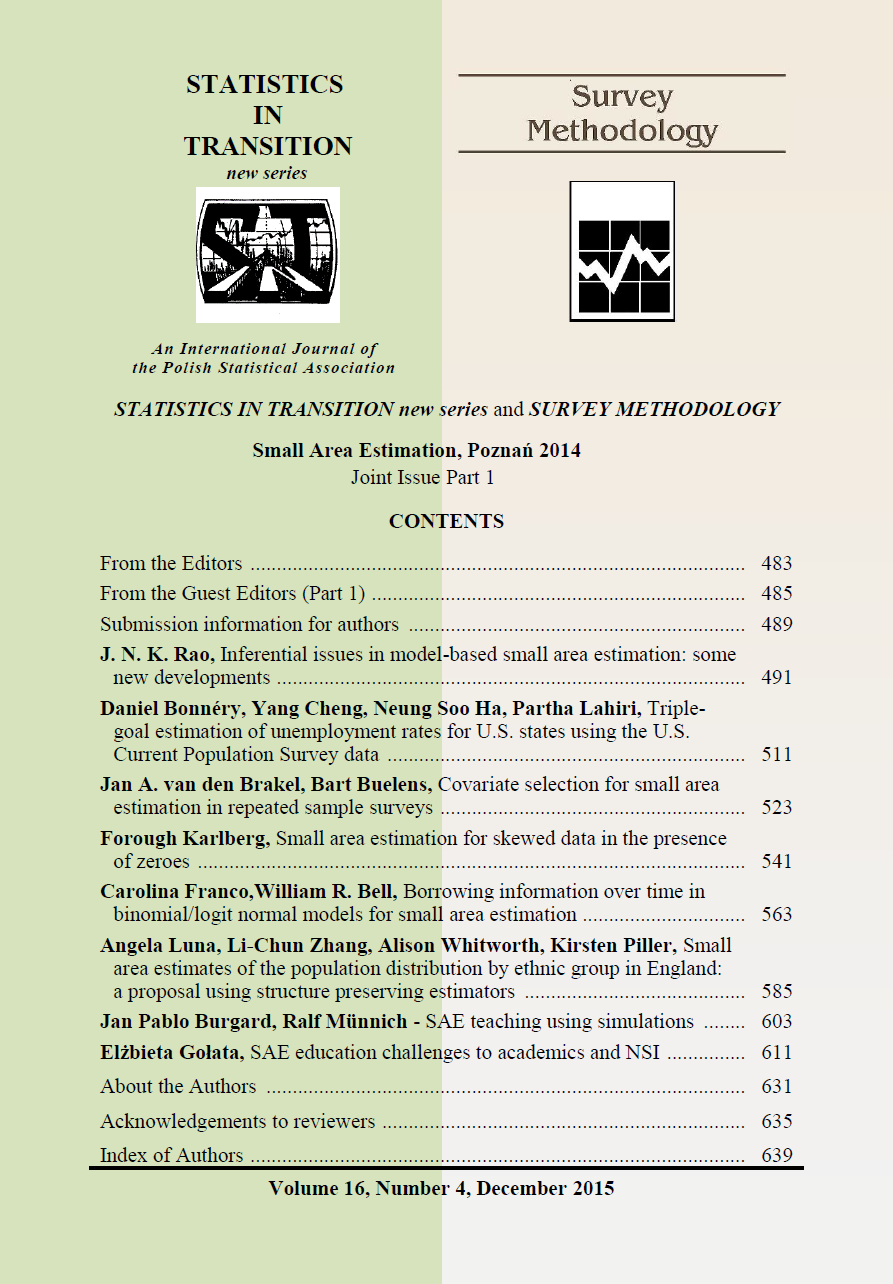ARTICLE
ABSTRACT
Linear area level models for small area estimation, such as the Fay-Herriot model, face challenges when applied to discrete survey data. Such data commonly arise as direct survey estimates of the number of persons possessing some characteristic, such as the number of persons in poverty. For such applications, we examine a binomial/logit normal (BLN) model that assumes a binomial distribution for rescaled survey estimates and a normal distribution with a linear regression mean function for logits of the true proportions. Effective sample sizes are defined so variances given the true proportions equal corresponding sampling variances of the direct survey estimates. We extend the BLN model to bivariate and time series (first order autoregressive) versions to permit borrowing information from past survey estimates, then apply these models to data used by the U.S. Census Bureau’s Small Area Income and Poverty Estimates (SAIPE) program to predict county poverty for school-age children. We compare prediction results from the alternative models to see how much the bivariate and time series models reduce prediction error variances from those of the univariate BLN model. Standard conditional variance calculations for corresponding linear Gaussian models that suggest how much variance reduction will be achieved from borrowing information over time with linear models agree generally with the BLN empirical results
KEYWORDS
area level model, complex surveys, American Community Survey, bivariate model, SAIPE.
REFERENCES
BELL, W. R., BASEL, W. W., CRUSE, C., DALZELL, L., MAPLES, J. J., O’HARA,B., POWERS, D. (2007). Use of ACS Data to Produce SAIPE Model-Based Estimates of Poverty for Counties. SAIPE technical report, U.S. Census Bu reau, URL http://www.census.gov/did/www/saipe/publications/files/report.pdf.
BELL, W. R., BASEL, W. W., MAPLES, J. J., (2015). An Overview of the U.S.Census Bureau’s Small Area Income and Poverty Estimates (SAIPE) Program.In Analysis of Poverty Data by Small Area Methods, Monica Pratesi (ed.), Lon don: Wiley, to appear.
BOX, G. E. P., JENKINS, G. M. (1970). Time Series Analysis: Forecasting and Control, San Francisco: Holden Day.
BROWN, L. D., CAI, T. T., DASGUPTA, A., (2001). Interval Estimation for a Binomial Proportion, Statistical Science, 16, 101-133.
BROWN, G., CHAMBERS, R., HEADY, P., HEASMAN, D. (2001). Evaluation of Small Area Estimation Methods – An Application to Unemployment Estimates from the UK LFS. In Proceedings of the Statistics Canada Symposium 2001,Achieving Data Quality in a Statistical Agency: A Methodological Perspective.
DATTA, G. S., LAHIRI, P., MAITI, T., LU, K. L. (1999). Hierarchical Bayes Estimation of Unemployment Rates for the States of the U.S. Journal of the American Statistical Association, 94, 1074-1082.
ESTEBAN, M. D., MORALES, D., PEREZ, A., SANTAMARIA, L., (2012).Small Area Estimation of Poverty Proportions Under Area-Level Time Mod els. Computational Statistics and Data Analysis, 56, 2840-2855.
FAY, R. E., HERRIOT, R. A. (1979). Estimation of Income for Small Places:An Application of James-Stein Procedures to Census Data. Journal of the American Statistical Association, 74, 269–77.
FRANCO, C., BELL, W. R. (2013). Applying Bivariate Binomial/Logit Nor mal Models to Small Area Estimation. Proceedings of the American Statis tical Association, Section on Survey Research Methods, 690–702, URL http://www.amstat.org/sections/srms/Proceedings/.
GHOSH, M., NATARAJAN, K., STROUD, T.W.F., CARLIN, B.P. (1998). Gen eralized Linear Models for Small Area Estimation. Journal of the American Statistical Association, 93, 273–282.
GHOSH, M., NANGIA, N., KIM, D. H. (1996). Estimation of Median Income of Four-Person Families: A Bayesian Time Series Approach. Journal of the American Statistical Association, 91, 1423-1431.
HAWALA, S., LAHIRI, P. (2012). Hierarchical Bayes Estimation of Poverty Rates.Proceedings of the American Statistical Association, Survey Research Methods Section, 3410–3424, URL http://www.census.gov/did/www/saipe/publications/files/hawalalahirishpl2012.pdf.
HUANG, E. T., BELL, W. R. (2012). An Empirical Study on Using Previous Amer ican Community Survey Data Versus Census 2000 Data in SAIPE Models for Poverty Estimates. Research Report Number RRS2012–4, Center for Statisti cal Research and Methodology, U.S. Census Bureau, URL http://www.census.gov/srd/papers/pdf/rrs2012–04.pdf.
LIU, B. M., LAHIRI, P., KALTON, G. (2007). Hierarchical Bayes Modeling of Survey Weighted Small Area Proportions. Proceedings of the American Sta tistical Association, Survey Research Section, 3181–3186.
PLUMMER, M. (2010). JAGS - Just Another Gibbs Sampler (JAGS 2.1.0.,May 12, 2010). URL https://sourceforge.net/projects/mcmc-jags.
PRATESI, M., GIUSTI, C., MARCHETTI, S., SALVATI, N., TZAVIDIS, N.,MOLINA, I., DURBÁN, M., GRANÉ, A., MARÍN, J. M., VEIGA, M. H.,MORALES, D., ESTEBAN, M.D., SANCHEZ, A., SANTAMARÍA, L., ´MARHUENDA, Y., PÉREZ, A., PAGLIARELLA, M. C., RAO, J. N. K.,FERRETTI, C. (2010). Small Area Estimation of Poverty and Inequality Indi-cators: Pilot Applications. Work Package 2 (D17) of Small Area Methods for Poverty and Living Conditions Estimates Project. URL http://www.sample project.eu/SAMPLEwp2d17.pdf.
R CORE TEAM (2013). R: A Language and Environment for Statistical Com puting. Vienna, Austria: R Foundation for Statistical Computing. URL http://www.R-project.org/.
RAO, J. N. K., MOLINA, I. (2015). Small Area Estimation (2nd ed.), Hoboken,New Jersey: Wiley.
SAEI, A., CHAMBERS, R. (2003). Small Area Estimation Under Linear and Gen eralized Linear Mixed Models with Time and Area Effects. Southampton,UK, Southampton Statistical Sciences Research Institute. (S3RI Methodology Working Papers, (M03/15)). URL http://eprints.soton.ac.uk/8165/.
SLUD, E. V. (2000). Models for Simulation and Comparison of SAIPE Analyses.
SAIPE Technical Report, U.S. Census Bureau, URL http://www.census.gov/did/www/saipe/publications/files/saipemod.pdf.
SLUD, E. V. (2004). Small Area Estimation Errors in SAIPE Using GLM versus FH Models. Proceedings of the American Statistical Association, Section on Survey Research Methods, 4402–4409, URL http://www.amstat.org/sections/srms/Proceedings/.
TACIAK, J., BASEL, W. W. (2012). Time Series Cross Sectional Approach for Small Area Poverty Models. Proceedings of the American Statistical Associa tion, Section on Government Statistics, URL http://www.census.gov/did/www/saipe/publications/files/JTaciakBaseljsm2012.pdf.
U.S. CENSUS BUREAU (2014). American Community Survey Design and Method ology (version 2.0, January 2014), URL http://www.census.gov/acs/www/methodology/methodology_main/.
YOU, Y. (2008). An Integrated Modeling Approach to Unemployment Rate Esti mation for Sub-Provincial Areas of Canada. Survey Methodology, 34, 19-27
